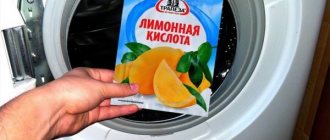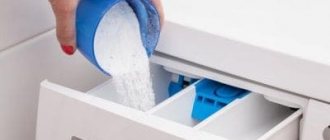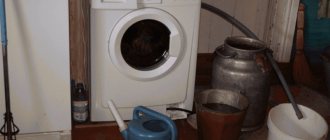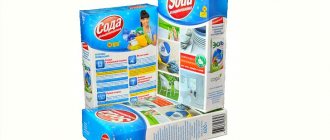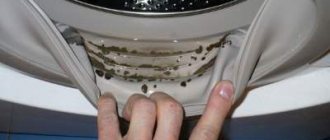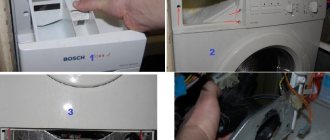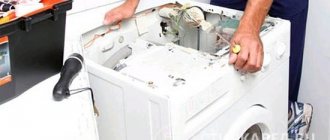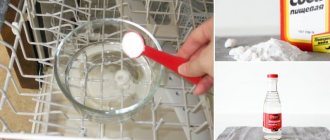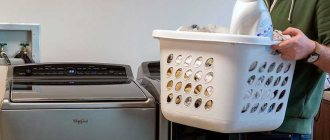Today, a washing machine can be found in almost every home. It saves a lot of time and makes our life easier. But this hardworking assistant periodically needs to be cleaned to remove scale and unpleasant odors. To remove them, experts recommend using advertised chemical cleaners. We would like to draw your attention to household products that are easy to use at home. An indispensable assistant in this matter is an effective natural and, importantly, inexpensive remedy, proven over decades - vinegar! Its main advantages:
- accessibility, always “at hand”;
- antibacterial and disinfectant properties;
- perfectly removes scale:
- safety for both humans and the parts of the washing machine.
In this article we will tell you how to quickly clean an automatic washing machine with vinegar. It will easily and carefully free all parts inside the machine from dirt.
Causes of scale and unpleasant odor
The main reason for the formation of scale: “hard” water containing calcium and magnesium salts dissolved in it. During washing, calcium and magnesium compounds decompose into carbon dioxide and insoluble sediment - lime deposits that stick to machine parts and heating elements. This is how scale forms on the heating element. Unfortunately, the quality of our tap water makes it impossible to prevent the appearance of limescale.
Colonies of microorganisms and mold are the source of unpleasant odors. Comfortable conditions for their reproduction:
- Mold on the drum and heating element appears at high humidity and low temperature. “Short” washing programs at temperatures below 40 degrees should be avoided as much as possible;
- Crumbs and pieces of paper remaining in clothing pockets sticking to the walls of the drum serve as food and a basis for colonies of bacteria and mold. It is imperative to remove these small particles from the drum and wipe its surface;
- Residues of powder and conditioner in the detergent container, as well as water at the bottom of the drum, are a favorable environment for the growth of bacteria and mold. After washing, these parts must be wiped dry;
- Mold may appear on the damp rubber sealing ring around the hatch - after finishing washing, the ring must be wiped of moisture.
- Small particles of dirt and pieces of rust from the water settle on the filter and form the basis for the accumulation of bacteria and mold. It is necessary to regularly clean the filter and promptly replace it with a new one.
NOTE! To increase the service life of the device, immediately after washing clothes, rinse and wipe dry the inner surface of the tank, the detergent container, and regularly clean the filters. It is better to keep the loading hatch door slightly open for natural ventilation in the washing machine.
But places such as heating elements with a deposit of washing powder and scale formed on them, and other surfaces of the internal parts of the machine are inaccessible for manual cleaning and rinsing.
Regular table vinegar will help solve this problem without much difficulty.
Why does scale form?
The formation of scale and plaque on the internal parts of the washing machine is influenced by only three factors:
- hard and polluted water;
- regular use of an automatic washing machine in intensive washing mode;
- low-quality washing powder, which contains many chemical components.
Very often scale forms in places with limited access. After considering the question of how to descale a washing machine with vinegar, you will understand that the cleaning process is accessible and understandable.
How to clean a washing machine with vinegar - step-by-step instructions
Over many decades, cleaning a washing machine with vinegar has shown its effectiveness, and the results are not inferior to rather expensive household chemicals. Experienced housewives use this method not only to save money. They are also attracted by its ease of use.
Step-by-step instructions will help you verify this using the example of cleaning a washing machine with 9% vinegar:
- Before starting work, make sure that the washing machine drum is empty.
- Pour a glass (200-250 ml) of 9% table vinegar into the powder compartment.
- Select the longest washing program with maximum temperature (90-95 degrees) and start it.
- When the water in the machine heats up (after about 20-25 minutes), stop the program by pressing the “Pause/Stop” button and leave for 1–1.5 hours.
- Turn on the machine by pressing the “Start” button to end the wash cycle.
- Clean the drain filter from scale.
- Dissolve 50 ml of vinegar in a liter of water and wipe the drum, rubber sealing ring with the resulting solution, and remove dirt from the surface of the door glass.
- To completely rinse the internal parts from residual acetic acid and scale, run the machine again, but for the shortest cycle with intensive rinsing turned on. No need to add any cleaning agents or detergents!
- When the process is finished, be sure to clean the drain filter again.
- Finally, wipe the drum, rubber o-ring, and hatch glass dry.
To enhance the impact on mold, you can clean your washing machine with vinegar and soda. In this case, a glass of 9% table vinegar is poured into the drum. A soda solution (1 tablespoon and 100 ml of water) is placed in the washing powder compartment. Then proceed according to the instructions, starting from point 3.
NOTE! Only 9% vinegar is used for descaling. The concentration of vinegar essence is 70%. Its use in its pure form can damage machine parts, especially plastic and rubber ones.
The easiest and most memorable rule for diluting the essence with water to obtain a 9% solution of acetic acid: the ratio with water is 1:7. In our case, from 30 ml of vinegar essence 70% and 210 ml of water (30 * 7) we get 240 ml of 9% vinegar.
Subtleties of using citric acid
Let's consider one of the safest options that will help you forget about scale forever, without harming your washing machine. You must first remove all the laundry from it. Wipe the drum dry. Close the door tightly. Pour 3 tablespoons of household citric or carboxylic acid into the powder compartment and start the boiling mode (95 degrees).
The most optimal mode for washing cotton items will be. For the best effect, you need to install several additional rinses. The water will finally wash away all the destroyed scale and clean the inside of the machine. In this case, there is no need to set the spin mode, since there is no laundry in the machine. After cleaning, do not forget to check the drain hose and the rubber seal, where scale residues may have gotten in.
As a result of this cleaning method, you can get an excellent result in descaling, as well as return the washing machine to newness, and as a result, save a considerable amount of kilowatts of electricity. But it is important to know that this procedure should not be carried out more than 2 times a year.
Citric acid has fairly mild properties in relation to the rubber parts of the washing machine and in comparison with various industrial oxidizing agents.
You should not clean the electric heater with citric or carboxylic acid more often than recommended, since the acidic environment can wash away the lubricant that is used to treat the seals and some other spare parts of the washing machine, and this will not have the best effect on the operation of the automatic washing machine. Sometimes it happens when When hot water and acid interact, the temperature sensor may go astray.
During the cleaning process, along with citric acid, it is necessary to add special descaling agents, which can be purchased at a hardware store, so that they help remove the remnants of the removed scale along with water.
The combination of chlorine and citric acid will also help descale the electric heater. You should combine these two components in equal parts (for example, 1 glass each) and do all the manipulations described above. After this, the washing machine will sparkle clean, and chlorine will help get rid of bacteria that settle in hard-to-reach parts of the machine, which later causes unpleasant odors.
How to remove musty smell
If an unpleasant musty smell appears in the washing machine, this should serve as a signal that the internal parts of the machine need cleaning. But first of all, you need to establish the cause of the smell:
- Rare use of the machine, lack of natural ventilation due to a tightly closed hatch;
- Storing dirty clothes in a drum;
- Remains of water at the bottom of the drum, contamination of the tray or detergent supply channel with residues of powder or conditioner;
- Dirty drain hoses, filter
Vinegar combined with baking soda will help remove the smell at home. This method is described in the previous section.
NOTE! The smell may be caused by poor sewerage.
Surface cleaning
As a rule, people simply wipe the washing machine with a regular cloth, without paying attention to other, smaller details.
After some time, the housewife notices that she will have to put maximum effort and time into cleaning, since over time, the remnants of powder, conditioner and bleaches form a dense layer. How to clean the outside of a washing machine with vinegar? It is a good habit to wipe the machine and powder tray after each wash, but if this does not happen, then you can clean it with a regular toothbrush and dishwashing liquid with a small addition of 9% vinegar essence to the water. The product must be diluted in a ratio of 5:1 and rub the stained areas with a brush, then wash off the remaining foam with a sponge. Then wipe dry with a clean cloth.
Cleaning the powder container
The detergent container requires more frequent cleaning.
The narrow channel for supplying detergents quickly becomes clogged with dense crumbs of washing powder, onto which thick conditioner sticks. In conditions of high humidity, colonies of microorganisms and mold form on the external and internal walls of the container.
Step-by-step instructions for cleaning the container:
- Pour warm water and a glass (250 ml) of 9% vinegar into a deep container.
- Leave for several hours (at least 2).
- Then use a brush (you can use a toothbrush) or a stiff sponge to remove any remaining powder and dirt.
- Rinse the container well with running water and wipe dry.
Important! Choose a container so that the container is completely submerged in water.
If traces of mold are visible on the walls of the container, additional treatment can be carried out:
- Apply a mixture of soda and water (ratio 1:1) to the walls of the tray.
- Leave for 2 hours.
- Remove plaque and traces of mold with a brush or sponge.
- Rinse the container well with running water and wipe dry.
Important! When we add vinegar to the washing machine in low concentrations (9%), it does not harm external surfaces or internal parts. But, in order to avoid prolonged contact of acid with rubber and plastic parts, after cleaning it is necessary to rinse them well with water and wipe them.
Prevention
It is always easier to prevent a problem than to fix it. To ensure that your machine serves you for a long time and without failure, we suggest that you adhere to the following recommendations.
- Use powder, conditioner, bleach in the required quantity specified in the instructions. Excess detergents settle on the parts of the washing machine.
- After each wash, wipe the rubber o-ring, drum, and hatch door glass dry.
- Rinse the detergent tray and wipe the recess into which it is inserted.
- Before placing laundry in the drum, remove any excess items from the pockets.
- Do not store dirty laundry or washed laundry in the machine. take it out immediately.
- Clean the drain hose filter regularly and replace it as necessary.
- At least once a month, wash your clothes at maximum temperature.
- Avoid using low quality powders.
- For natural ventilation and evaporation of excess moisture, always keep the hatch door ajar.
- At least once every 6 months (more often with very hard water) you need to clean the washing machine with vinegar.
By following these simple tips, you will not encounter any unpleasant consequences for your machine.
Advantages and disadvantages
- Vinegar is an acid, so the results are guaranteed to be pronounced. It effortlessly helps to corrode plaque, which makes it possible to remove it even from the most inaccessible areas.
- If you descale your washing machine in accordance with all the rules, then the likelihood of clogging the unit with a scale particle is practically reduced to zero.
- During cleaning, you can not only get rid of the scale present on the washing unit, but also remove unpleasant odors, which quite often appear during regular use of the equipment.
- The use of acetic acid is one of the most effective methods of our time, and its effectiveness is not inferior to any expensive means.
As for the disadvantages of the method, there is only one - the specific smell of the product.
Getting rid of this disadvantage is quite simple; just rinse the machine again and ventilate the room while cleaning it.
Can I clean my washing machine with this product? Acetic acid harms the washing machine, so it is recommended to use it no more than once a quarter.
Advantages of the product:
- Affordable price - everyone can afford to buy the product.
- Dissolves lime and has an antibacterial effect.
- Neutralizes unpleasant odors.
- Not very aggressive, so safe to use.
- Removes mold.
The effect of acetic acid lasts for a long time, so one-time cleaning is strongly recommended.
And now about the disadvantages of the product. Acetic acid reacts with copper. If there are copper gaskets, then you cannot clean the washing machine with this product.
Fillings may lose their sealing effect if acetic acid is used regularly.
Disadvantage: unpleasant smell. It is necessary to turn on the rinse mode several times to get rid of it.
The rubber seal, thanks to which the door closes tightly and water does not spill out, can become rough and tear during washing if you use this product too often.
To regularly clean the machine from scale or mold, it is recommended to use alternative products, citric acid solution or soda.
Even repairmen consider citric acid the best home remedy for scale. It is included in some industrial scale removal products and will not damage rubber seals or hoses.
